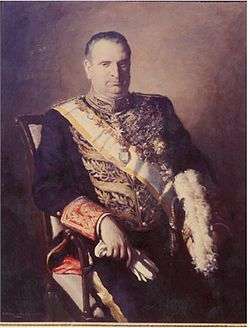Alberto Martín-Artajo

Alberto Martín-Artajo Álvarez (Madrid, 1905–1979) was a legal technocrat for the Nationalist (rebel) government during the Spanish Civil War and for the succeeding dictatorship of Francisco Franco, and a Spanish Minister of Foreign Affairs. He served as the Foreign Minister from 1945 to 1957. Ideologically, he was not a Falangist (a member of the original Falange Española, the fascist-like party, before it absorbed the other anti-Republican parties), but a monarchist and a leader of the dynamic and powerful Catholic movement within the Francoist coalition. During the time of the Second Spanish Republic, he had been a member of the Spanish Confederation of the Autonomous Right (CEDA, existed 1933–1937).[1]
He received his secondary education at the Colegio Nuestra Señora del Recuerdo. Martín-Artajo earned a law degree from the University of Madrid. He became a staff attorney of the Council of State in 1931.[2] During the Republic, Martín-Artajo worked closely with Ángel Herrera Oria, the director of the Catholic newspaper El Debate and belonged to the lay "National Catholic Association of Propagators of the Faith" (propagandistas). With the start of the Spanish Civil War, Martín-Artajo went over to the insurgent Nationalists. He was a legal adviser to the Nationalist government's Junta Técnica del Estado (State Technical Council), Franco's pseudocabinet,[3] and to the Nationalist government's Labor Ministry. In 1940, General Franco appointed him president of the mass movement, Catholic Action.
In 1945, Martín-Artajo participated in the drafting of the quasiconstitutional "Fuero of the Spanish People", a list of rights, freedoms, and responsibilities.
In July 1945, fresh after the defeat of fascist Germany, Franco wanted to present the Spanish government as "Catholic" rather than a profascist, in the face of ostracism from other Western countries. Franco wanted to appoint Martín-Artajo Minister of Foreign Affairs.[4][5] After consulting with the Primate of Spain, Cardinal Enrique Pla y Deniel, he accepted the portfolio of Foreign Affairs and resigned from his position at Catholic Action. His diplomatic efforts succeeded in breaking the dictatorship's isolation.[6] He effectuated the signing of the Concordat with the Holy See in August 1953, the bilateral Pact of Madrid[7] with the United States the following September,[8] and Spain's entry into the United Nations in 1955.
After retiring from the Foreign Ministry, he worked on the Council of State and at the publisher, Editorial Católica.
Notes
- ↑ Preston 1995:111-119
- ↑ El País 31 August 1979
- ↑ At the beginning of the Civil War (July 1936), the insurgents created the Junta de Defensa Nacional (National Defense Council) to carry out the function of the Council of Ministers, the Spanish cabinet. The JDN was replaced by the Junta Técnica del Estado (State Technical Council) on 1 October 1936. Finally, a cabinet composed of ordinary ministerial departments was created by a law of 30 January 1938. See Linz et al., no date, p. 3 and fn. 6, and Jerez 1992:8
- ↑ Palomares 2005:11
- ↑ Portero 2007
- ↑ New York Times 1956
- ↑ in Spanish, the Acuerdos hispano-norteamericanos
- ↑ Calvo-González 2007
References
- Calvo-González, Oscar. 2007. American Military Interests and Economic Confidence in Spain under the Franco Dictatorship. Journal of Economic History, 2007 September, 67(3):740-767.
- El País. 31 August 1979. Obituary of Alberto Martín-Artajo.

- Jerez, Miguel. 1992. Business and Politics in Spain: From Francoism to Democracy. Institut de Ciències Polítiques i Socials, Universitat Autònoma de Barcelona, Working Paper No. 52.
- Linz, Juan J., Miguel Jerez, and Susana Corzo. No date. Ministers and Regimes in Spain: From First to Second Restoration, 1874-2001. Center for European Studies Working Paper No. 101.
- New York Times. 10 April 1956. Franco's Voice Abroad; Alberto Martin Artajo Early Catholic Leader
- Palomares, Cristina. 2005. The quest for survival after Franco: moderate Francoism and the slow journey to the polls, 1964-1977. Brighton: Sussex Academic Press.
- Portero, Florentino. 2007. [www.abc.es/hemeroteca/historico-03-12-2007/abc/Opinion/el-legado-castiella_1641446866614.html El legado Castiella]

- Preston, Paul. 1995. The Politics of Revenge: Fascism and the Military in Twentieth-century Spain. Routledge.
Further study
- España durante el franquismo slide show at www.slideshare.net
- Tusell, Javier. 2007. Spain: From Dictatorship to Democracy: 1939 to the Present. Blackwell.
|